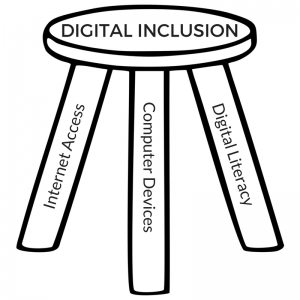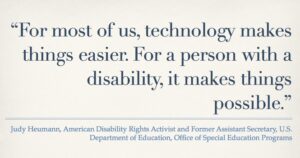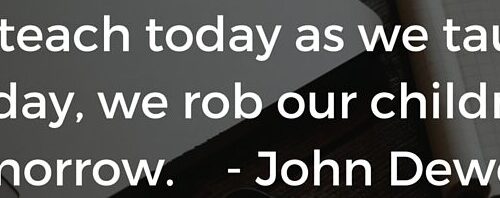Does Technology Lead to a More Equitable Society? A Complicated Yes.
Technology has opened countless doors for me and provided me with many opportunities that make my life convenient. Without it, I wouldn’t be finishing my master’s degree. I wouldn’t be able to connect with people around the world, sign up for courses in seconds, or complete everyday tasks like banking, shopping, or lesson planning—all from a click of a button.
This week’s topic of whether technology leads to a more equitable society made me reflect on who exactly benefits from technology and who does not. And while we live in a digital world, in which technology is in every aspect of our lives, does that mean that society is more equitable? Or has technology just made life easier for those who already have access and privilege.
This week’s debate challenged my assumption that technology benefits everyone equally. I have realized how naïve it is to believe that simply having access to digital tools means having the same opportunities. In fact, technology often mirrors the inequalities already present in society. Just because tools exist does not mean they are equally usable or beneficial for all.
Equality vs. Equity: A Crucial Distinction
One of the most important takeaways from this week’s debate was learning the difference between equality and equity. Jillian and Danielle broke this down in their debate:
- Equality is giving everyone the same tool—ex. everyone gets a textbook
- Equity is giving each student what they actually need to succeed- ex. the student who is nearsighted, needs a book with larger print or glasses.
When I truly reflect on my current practices in my classroom, I think I have missed the marked. Just because everyone has access to a Chromebook to complete an assignment, doesn’t mean their individual learning needs have been met. A Chromebook doesn’t help my student who struggles to read. The statement “The fundamental flaw in equality-based education is that by treating every student the same, you fail to see them as individuals” really resonated with me. It reminded me that equity isn’t about giving all students the same tools, it is about giving each student the right tools. Going forward, I need to be more intentional in how I use technology to support my diverse learners, not just assume that access equals success.
Yes, Technology!
On the “agree” side of the debate, Sarada and Chi presented a hopeful and compelling case that technology has indeed contributed to a more equitable society. They argued that digital tools can help bridge critical gaps in healthcare, education, and economic opportunity. For example, AI and automation can make essential services more affordable and accessible. Digital inclusion, through access to devices and internet connectivity, can offer students opportunities they may never have otherwise had. Assistive technologies have transformed learning for students with intellectual and cognitive disabilities. And global connectivity through mobile devices and the internet fosters cultural exchange and collaboration across borders. These examples show how, when implemented thoughtfully, technology can expand access and create more equitable outcomes.
more equitable society. They argued that digital tools can help bridge critical gaps in healthcare, education, and economic opportunity. For example, AI and automation can make essential services more affordable and accessible. Digital inclusion, through access to devices and internet connectivity, can offer students opportunities they may never have otherwise had. Assistive technologies have transformed learning for students with intellectual and cognitive disabilities. And global connectivity through mobile devices and the internet fosters cultural exchange and collaboration across borders. These examples show how, when implemented thoughtfully, technology can expand access and create more equitable outcomes.
There is no doubt that technology can be an equalizer. But the question remains whether it is enough?
No, Technology!
On the other side of the debate, Jillian and Danielle stated that access to technology is not a magic wand. It does not erase the deeper systemic issues like poverty, racism, or social exclusion. It was interesting to learn that technology based solutions can actually promote exclusion “disguised as progress”. They also highlighted that the digital divide is more than just a gap in devices or internet, stating it is an equity crisis. According to research from 383 global studies, digital inequality continues to block educational opportunities, especially for those already marginalized.
systemic issues like poverty, racism, or social exclusion. It was interesting to learn that technology based solutions can actually promote exclusion “disguised as progress”. They also highlighted that the digital divide is more than just a gap in devices or internet, stating it is an equity crisis. According to research from 383 global studies, digital inequality continues to block educational opportunities, especially for those already marginalized.
What was particularly interesting during the debate was the discussion around telehealth. Telehealth is a way to have an appointment with your doctor, nurse or other healthcare professional from home or work. When it is done by video meeting, it can be called a “virtual consultation” or a “virtual appointment. But, just because someone can access a doctor virtually with the click of a button, is this equity? No. According to Public Health Ontario, this particular method “may not be suitable for all populations and as a result, may consequently widen health inequities for populations who have historically and systemically excluded from the health system.” Furthermore, telehealth is only useful if communities have strong and stable internet connectivity.
Assistive Technologies
 In education, we assume that assistive technology can remove barriers to learning for students with learning disabilities however data shows that many students with LDs continue to face inappropriate classroom placement or streaming options which can limit their post-secondary opportunities. Unfortunately, these wrong placements may lead to poor self-esteem and increased chances of students not completing their educational goals. The solution : A balanced and well-monitored approach to the use of assistive technology is the most equitable solution for supporting students with learning disabilities.
In education, we assume that assistive technology can remove barriers to learning for students with learning disabilities however data shows that many students with LDs continue to face inappropriate classroom placement or streaming options which can limit their post-secondary opportunities. Unfortunately, these wrong placements may lead to poor self-esteem and increased chances of students not completing their educational goals. The solution : A balanced and well-monitored approach to the use of assistive technology is the most equitable solution for supporting students with learning disabilities.
Data Reveals Realities in the World
When I researched more about this topic, I learned that 65% of youth worldwide lack the digital skills needed for 90% of today’s jobs, a staggering gap that reveals just how unprepared many are for the future. Even more troubling, 240 million children with disabilities lack access to assistive technologies. These statistics are a powerful reminder that simply living in a digital age does not guarantee meaningful progress. Despite the advances in technology, we still have a long way to go in building a truly equitable society.
To ensure inclusive and equitable opportunities for digital education, UNICEF states that the following must be addressed:
- Connectivity and infrastructure divides- network quality and coverage, disparities in access to devices and electricity both at home and at school
- Digital skills divides; online safety and digital well-being
- Social divides; language, gender, caste and location divides, as well as for children with disabilities, and children from linguistic, ethnic and religious minority groups
My Take-Aways
To assume that technology can solve all the world’s problems is to overlook the root causes of inequality. As this article states, “technology can even exacerbate existing disparities by creating new forms of digital marginalization.” Simply put, technology alone does not make our society more equitable. In Canada alone, we must confront key issues like expensive cellular data packages and why over half of rural households still lack access to adequate high-speed internet. The rural-urban digital divide is more than a connectivity issue, it is an equity issue and must be addressed.
In education, technology alone does not ensure equity. To truly meet the individual needs of our students, we must go beyond devices and internet connection. According to the following article , addressing the digital divide requires a human-centered approach, one that recognizes the complexities of each learner. Technology must be used with intention, not just as a one-size-fits-all solution. To achieve equitable learning environments we must:
- Measure the effectiveness of our learning technologies
- Invest in professional learning that leads to meaningful change
- Consider the whole child, not just academic outcomes
- Involve families and the broader community in the process, and
- Use technology to increase representation and support diverse voices and interests.
- Never lose sight of what matters most in education- relationships
Relationships are the ultimate key to an educational system that is equitable for all.

7 Comments
Carol Preece
Hi Leanne,
Thank you for your thoughtful post. I really enjoyed reading the UNICEF article – the statistic about the number of youth that are ill prepared for jobs of the future is staggering! I agree that there is a lot of work to do but, when reading further into the article, I was encouraged by the programs that are already helping youth in many parts of the world gain the skills that they will need to enter the workforce.
You also mentioned the disparity here in Canada. I mentioned this in my post as well this week. It frustrates me that in a country as rich and vast as Canada, we still have inequality in infrastructure and accessibility.
Thanks for a great, well balanced look into the debate!
Kritika Sehgal
Leanne, your blog is all so good. I loved how you unpacked the difference between equality and equity and that Chromebook example was so relatable. As a former teacher, I’ve often seen how simply giving students the same tools doesn’t guarantee success. Your reflection reminded me of my own classroom moments when I realized some learners needed much more than just access.
I also appreciated how you highlighted the statistics around digital skills and access. That UNICEF list at the end was such a practical takeaway; it makes me think about how intentional we need to be as educators when integrating technology.
What resonated with me most was your closing reminder: “relationships are the ultimate key.” Even with all the digital tools in the world, the human connection between teacher and student is what truly shapes equity. Your blog made me think how I can use technology with more purpose rather than just assuming it as a quick fix.
Kritika
Danielle Ryhorchuk
Leanne, what a great reflection! I really appreciated how you wove together research, debate highlights, and your personal insights so seamlessly. Because I was on the disagreeing side, reading your post really validated so many of the arguments we tried to convey. Like you, I started off believing that technology naturally levels the playing field, but the more I researched and engaged with real-life examples, the more I realized that tech often reinforces existing inequalities.
Your point about Chromebooks in the classroom especially hit home. I’ve seen the same issue and just because students have access doesn’t mean they have what they need. And the distinction between equality and equity is so essential to keep at the forefront when we’re integrating tech into education.
Thanks for sharing such a deep, honest post. I couldn’t agree more with your conclusion: technology alone isn’t the answer—but if we use it with intention and humanity, it can help get us closer.
Jillian Maas
Leanne, I loved how you used your own personal experiences and tied it into our debate topic😊 The Chromebook example stood out to me as a strong reminder that equal access does not mean equitable support, which was exactly what we were arguing. Your reflections helped me think more critically about my own assumptions when using technology in the classroom.. I found the UNICEF recommendations especially helpful, as they highlight many layers of digital exclusion that are often overlooked (again what we were debating on our side). I also think its so important to look beyond access to devices and internet and focus on meeting the unique needs of child in the classroom. Have a great summer. Fantastic blog!!!!!
Kaela
Leanne, I really appreciated your post on technology and equity; it was a thoughtful look at how access to digital tools alone doesn’t guarantee equitable learning. As I reflected on this in my own blog post, I found we shared many of the same concerns and hopes.
Your emphasis that equity isn’t just about devices or internet access, but also about training, support, and culturally responsive implementation, mirrors what I’ve seen in my classroom. When students have devices but no guidance, or tech that isn’t designed for diverse learners, the potential for learning remains untapped, even with access.
.
In my experience, I’ve seen tech succeed only when educators are supported and students are motivated, NOT just given a device. Without intentional design and training, tools can unintentionally widen gaps rather than bridge them.
Thanks again for sharing!
Jenni Peeke
I always love reading your thoughts on these debate topics, Leanne! Every time we chat I seem to learn something new. I really resonated with your point that “To assume that technology can solve all the world’s problems is to overlook the root causes of inequality.” While I agree that we can’t assume technology will SOLVE the inequality in the world, I think that it does help. Will it ever help everyone? We will never see a world without inequality… the real causes of inequality are so much more complicated than an internet connection and a device. I do hope that as more funding is put in place we will slowly see more opportunities provided to our marginalized communities, and see that technology being put to good use by the services who are there to help others.
Jenna Reimer-Jones
Hi Leanne,
I agree that this is a highly complex question to address. Like you, technology has provided me with opportunities that might not have been available otherwise. However, simply providing access to technology does not ensure that everyone benefits equally. I really appreciated the discussion on equity and equality as it was particularly insightful and very relevant to this topic. Having access to the same resources does not necessarily result in equitable education.
Your takeaways are extremely valuable, and I agree that a comprehensive plan is necessary, a plan that extends beyond simply providing devices and internet access.
Jenna